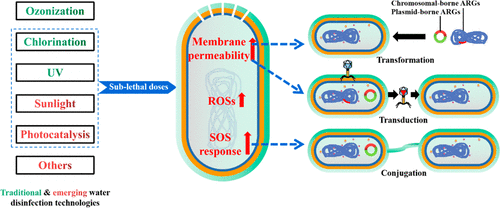当前位置:
X-MOL 学术
›
ACS ES&T Eng.
›
论文详情
Our official English website, www.x-mol.net, welcomes your
feedback! (Note: you will need to create a separate account there.)
Traditional and Emerging Water Disinfection Technologies Challenging the Control of Antibiotic-Resistant Bacteria and Antibiotic Resistance Genes
ACS ES&T Engineering ( IF 7.4 ) Pub Date : 2021-06-07 , DOI: 10.1021/acsestengg.1c00110 Yiwei Cai 1 , Tong Sun 1 , Guiying Li 1, 2 , Taicheng An 1, 2
ACS ES&T Engineering ( IF 7.4 ) Pub Date : 2021-06-07 , DOI: 10.1021/acsestengg.1c00110 Yiwei Cai 1 , Tong Sun 1 , Guiying Li 1, 2 , Taicheng An 1, 2
Affiliation

|
The emergence of antibiotic-resistant bacteria (ARB) and antibiotic resistance genes (ARGs) in the environment has created obstacles when treating infectious diseases with antibiotics. Wastewater treatment plants (WWTPs) serve as reservoirs for ARB and ARGs and can disseminate them into the environment. It is important to understand and address these risks. Generally, professional disinfection processes have been used in WWTPs to disinfect the target water body, with the goal of eliminating pathogenic microorganisms in the water. However, ARGs are not generally considered, and antibiotic resistance has spread and developed through horizontal gene transfer (HGT). This Review provides a detailed overview of the application progress of different traditional and new disinfection technologies in removing ARB and ARGs, mainly focusing on the bacterial inactivation mechanisms of chlorination, ozonation, ultraviolet (UV) (including UVA, UVB, and UVC), sunlight, sunlight-dissolved organic matter (DOM), and photocatalysis (PC)/photoelectrocatalysis (PEC). In addition, this Review also focuses on the disinfection technology involved in the transfer of ARGs and clarifies the underlying transfer mechanisms in water environments. Furthermore, by linking the mechanisms of bacterial inactivation, the Review describes how SOS response and cell membrane permeability may be the key step in the conjugation, transformation, and transduction of ARGs. Finally, given the applications and current problems associated with traditional water disinfection technologies and light-based disinfection technologies in removing and controlling ARB and ARGs, this Review describes the current challenges and opportunities to facilitate the development of future disinfection technologies. The Review also highlights future research directions related to ARG transmission control.
中文翻译:

传统和新兴水消毒技术挑战抗生素抗性细菌和抗生素抗性基因的控制
环境中抗生素抗性细菌 (ARB) 和抗生素抗性基因 (ARG) 的出现为用抗生素治疗传染病造成了障碍。废水处理厂 (WWTP) 作为 ARB 和 ARG 的蓄水池,可以将它们排放到环境中。了解和解决这些风险很重要。污水处理厂通常采用专业的消毒工艺对目标水体进行消毒,以消除水中的病原微生物。然而,一般不考虑 ARGs,抗生素耐药性已经通过水平基因转移 (HGT) 传播和发展。本综述详细概述了不同传统和新型消毒技术在去除 ARB 和 ARGs 方面的应用进展,主要侧重于氯化、臭氧、紫外线(UV)(包括UVA、UVB和UVC)、阳光、阳光下溶解的有机物(DOM)和光催化(PC)/光电催化(PEC)的细菌灭活机制。此外,本综述还重点介绍了 ARGs 转移中涉及的消毒技术,并阐明了水环境中的潜在转移机制。此外,通过将细菌灭活的机制联系起来,该评论描述了 SOS 反应和细胞膜通透性如何成为 ARG 结合、转化和转导的关键步骤。最后,鉴于传统水消毒技术和光基消毒技术在去除和控制 ARB 和 ARG 方面的应用和当前问题,本综述描述了当前促进未来消毒技术发展的挑战和机遇。该评论还强调了与 ARG 传输控制相关的未来研究方向。
更新日期:2021-07-09
中文翻译:

传统和新兴水消毒技术挑战抗生素抗性细菌和抗生素抗性基因的控制
环境中抗生素抗性细菌 (ARB) 和抗生素抗性基因 (ARG) 的出现为用抗生素治疗传染病造成了障碍。废水处理厂 (WWTP) 作为 ARB 和 ARG 的蓄水池,可以将它们排放到环境中。了解和解决这些风险很重要。污水处理厂通常采用专业的消毒工艺对目标水体进行消毒,以消除水中的病原微生物。然而,一般不考虑 ARGs,抗生素耐药性已经通过水平基因转移 (HGT) 传播和发展。本综述详细概述了不同传统和新型消毒技术在去除 ARB 和 ARGs 方面的应用进展,主要侧重于氯化、臭氧、紫外线(UV)(包括UVA、UVB和UVC)、阳光、阳光下溶解的有机物(DOM)和光催化(PC)/光电催化(PEC)的细菌灭活机制。此外,本综述还重点介绍了 ARGs 转移中涉及的消毒技术,并阐明了水环境中的潜在转移机制。此外,通过将细菌灭活的机制联系起来,该评论描述了 SOS 反应和细胞膜通透性如何成为 ARG 结合、转化和转导的关键步骤。最后,鉴于传统水消毒技术和光基消毒技术在去除和控制 ARB 和 ARG 方面的应用和当前问题,本综述描述了当前促进未来消毒技术发展的挑战和机遇。该评论还强调了与 ARG 传输控制相关的未来研究方向。











































 京公网安备 11010802027423号
京公网安备 11010802027423号